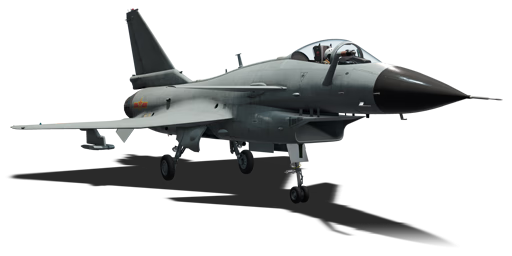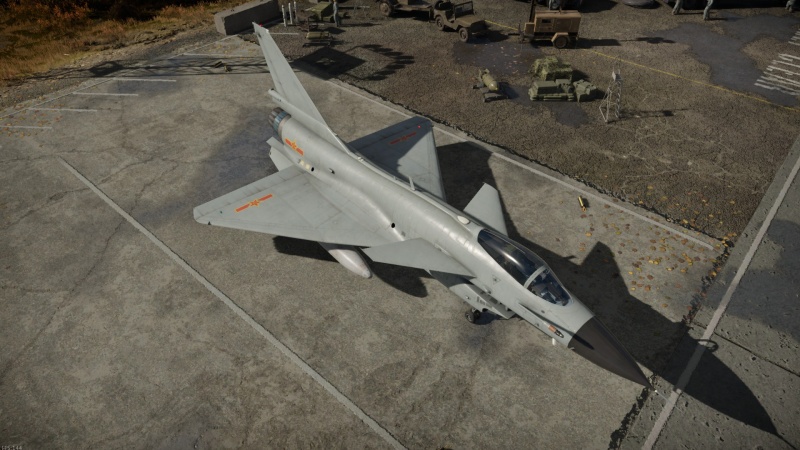J-10A
Contents
Description
The J-10A (Early)(歼-10A型歼击机), officially the K/AJJ10A, known by its nickname "Vigorous Dragon 猛龙" or by its NATO codename "Firebird", is the new generation single-seater multirole fighter for PLAAF since 2006 as the replacement of previous fleets of J-6 to J-8I series. Foreseeing the limitations of 2nd generation interceptors in the aerial combats of 1980s, engineers of Chengdu Aircraft Corporation has been working on a new generation jet fighter with some designs deemed innovative to Mainland China in 1960s all the way to 1978; although this program dubbed "J-9" bit the dust, one of its designs, J-9-VI series, which were known by their iconic canard design, were retained for further development in near future. By 1982, Song Wencong (宋文骢) brought in the J-9-VI aerodynamic model and impressed the officials during the hearing for the development of new interceptor; after the aerodynamic issues and further refinement on the J-9-VI design, the new aircraft would soon be named Project No. 10 (十号工程) and commence in 1986. This also brought in a major issue for the program: extremely high percentage of new components with very low compatibility to any previous interceptors, especially the digital FBW control which wasn't even been introduced to Mainland China at all; after addressing on the manufacturing difficulties and programmed for any possibility of scenarios for the FBW system, the J-10 rolled of the production line in 1997 and soared to the skies on March 23rd, 1998. With flight tests conducted successfully without any crashes and further refinements made to the design, J-10 delivered its lead-in series to PLAAF on March 2003 was certified for commission in 2004; by 2006, the new fighter was officially introduced in the year's national defense white paper.
It was introduced in Update "Dance of Dragons" as the end-on-the-line fighter for Chinese tech tree, J-10A brought in many much-appreciated features as an all-in-one multirole fighter which was lacking for the tech-tree; now featuring a Su-27 equivalent of BVR AAMs and selections of guided air-to-ground munitions which was once only available on JH-7A, J-10A can become a very formidable foe in battle with excellent maneuverability and impressive payload for its size.
General info
Flight performance
Describe how the aircraft behaves in the air. Speed, manoeuvrability, acceleration and allowable loads - these are the most important characteristics of the vehicle.
| Characteristics | Max speed (km/h at _,___ m) |
Max altitude (metres) |
Turn time (seconds) |
Rate of climb (metres/second) |
Take-off run (metres) | |||
|---|---|---|---|---|---|---|---|---|
| AB | RB | AB | RB | AB | RB | |||
| Stock | 2058 | 2006 | 16500 | 20.9 | 21.3 | 227.1 | 215.5 | 850 |
| Upgraded | ___ | ___ | __._ | __._ | __._ | __._ | ||
Details
| Features | |||||
|---|---|---|---|---|---|
| Combat flaps | Take-off flaps | Landing flaps | Air brakes | Arrestor gear | Drogue chute |
| _ | _ | _ | _ | _ | _ |
| Limits | ||||||
|---|---|---|---|---|---|---|
| Wings (km/h) | Gear (km/h) | Flaps (km/h) | Max Static G | |||
| Combat | Take-off | Landing | + | - | ||
| 0 | 620 | ___ | ___ | ___ | ~__ | ~__ |
| Optimal velocities (km/h) | |||
|---|---|---|---|
| Ailerons | Rudder | Elevators | Radiator |
| < ___ | < ___ | < ___ | - |
Engine performance
| Engine | Aircraft mass | |||||||
|---|---|---|---|---|---|---|---|---|
| Engine name | Number | Basic mass | Wing loading (full fuel) | |||||
| Saturn AL-31FN | 1 | _,___ kg | ___ kg/m2 | |||||
| Engine characteristics | Mass with fuel (no weapons load) | Max Gross Weight | ||||||
| Weight (each) | Type | _m fuel | __m fuel | __m fuel | ||||
| 1,520 kg |
|
_,___ kg | _,___ kg | _,___ kg | _,___ kg | |||
| Maximum engine thrust @ 0 m (RB/SB) | Thrust to weight ratio @ 0 m (___%/WEP) | |||||||
| Condition | 100% | ___%/WEP | _m fuel | __m fuel | __m fuel | MGW | ||
| Stationary | ___ kgf | ___ kgf | _.__ | _.__ | _.__ | _.__ | ||
| Optimal | ___ kgf (_ km/h) |
___ kgf (_ km/h) |
_.__ | _.__ | _.__ | _.__ | ||
Survivability and armour
Examine the survivability of the aircraft. Note how vulnerable the structure is and how secure the pilot is, whether the fuel tanks are armoured, etc. Describe the armour, if there is any, and also mention the vulnerability of other critical aircraft systems.
Modifications and economy
Armaments
| Ballistic Computer | ||||
|---|---|---|---|---|
| CCIP (Guns) | CCIP (Rockets) | CCIP (Bombs) | CCRP (Bombs) | EEGS |
| |
|
|
|
|
Offensive armament
The J-10A is armed with:
- 1 x 23 mm Type 23-3 cannon, belly-mounted (200 rpg)
- 72 x large calibre countermeasures
Suspended armament
Describe the aircraft's suspended armament: additional cannons under the wings, bombs, rockets and torpedoes. This section is especially important for bombers and attackers. If there is no suspended weaponry remove this subsection.
| Default weapon presets | |
|---|---|
| |
Usage in battles
Describe the tactics of playing in the aircraft, the features of using aircraft in a team and advice on tactics. Refrain from creating a "guide" - do not impose a single point of view, but instead, give the reader food for thought. Examine the most dangerous enemies and give recommendations on fighting them. If necessary, note the specifics of the game in different modes (AB, RB, SB).
Pros and cons
Summarise and briefly evaluate the vehicle in terms of its characteristics and combat effectiveness. Mark its pros and cons in the bulleted list. Try not to use more than 6 points for each of the characteristics. Avoid using categorical definitions such as "bad", "good" and the like - use substitutions with softer forms such as "inadequate" and "effective".
Pros:
- Good maneuverability even stock
- The PL-5EII has an IRCCM with reasonable efficiency (especially in the rear aspect)
- The PL-8 has a good turn rate and speed
- has access to the PL-12, a Fox 3 that can carry a good amount of these missiles
- The radar is efficient, it locks targets easily
- Although it is primarily air superiority, it can do some CAS
Cons:
- Its acceleration is considerably low, especially
- The PL-8 does not have IRCCM and on the other hand the PL-5EII does not have an exceptional turn rate for the BR.
- CAS is limited, it can only carry 2 air-to-ground guided weapons per payload.
History
Describe the history of the creation and combat usage of the aircraft in more detail than in the introduction. If the historical reference turns out to be too long, take it to a separate article, taking a link to the article about the vehicle and adding a block "/History" (example: https://wiki.warthunder.com/(Vehicle-name)/History) and add a link to it here using the main template. Be sure to reference text and sources by using <ref></ref>, as well as adding them at the end of the article with <references />. This section may also include the vehicle's dev blog entry (if applicable) and the in-game encyclopedia description (under === In-game description ===, also if applicable).
Media
Excellent additions to the article would be video guides, screenshots from the game, and photos.
See also
Links to the articles on the War Thunder Wiki that you think will be useful for the reader, for example:
- reference to the series of the aircraft;
- links to approximate analogues of other nations and research trees.
External links
| Chengdu Aircraft Industry Group (中航工业成都飞机工业集团) | |
|---|---|
| Jet Fighters | |
| J-7 | J-7II* · J-7D · J-7E |
| J-10 | J-10A |
| JF-17 | JF-17** |
| Drones | Wing Loong I |
| *Unlicensed and reverse-engineered version of the MiG-21. | |
| **Jointly developed and built by Chengdu Aircraft Industry Group and Pakistan Aeronautical Complex. | |
| See Also | Mikoyan-Gurevich Design Bureau · Pakistan Aeronautical Complex |
| China jet aircraft | |
|---|---|
| Fighters | J-2 · J-4 · J-6A · J-7II · J-7D · J-7E · J-8B · J-8F · J-10A · J-11 · J-11A |
| Strike aircraft | Q-5 early · Q-5A · Q-5L · A-5C · JH-7A |
| Bombers | H-5 |
| American | ␗F-84G-21-RE · ␗F-84G-31-RE · ␗F-86F-30 · ␗F-86F-40 · ␗F-100A · ␗F-100F · ␗F-104A · ␗F-104G · ␗F-5A · ␗F-5E · ␗F-16A MLU |
| Soviet | ␗MiG-9 · ␗MiG-9 (l) |
| North Korea | Shenyang F-5 |
| Pakistan | JF-17 |





